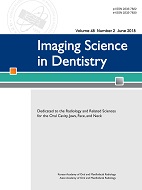

- P-ISSN2233-7822
- E-ISSN2233-7830
- Frequency Quarterly
- PublisherKorean Academy of Oral and Maxillofacial Radiology
- CCL
- Indexed byKCI,SCOPUS,ESCI
You can use ACOMS+ service with an AccessON integrated member account.
※ If you are already an AccessON integrated member, go back to the journal’s website and login.

